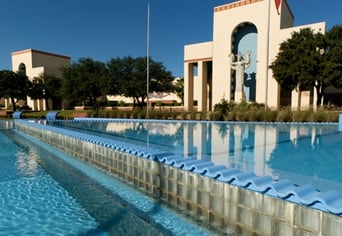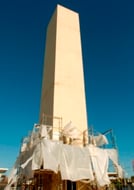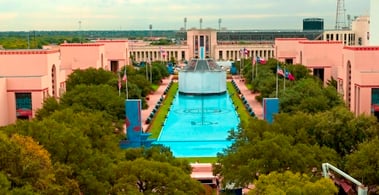Fair Park: Restoring a Texas Landmark
Fair Park is a unique National Historic Landmark that is home to entertai nment facilities, cultural centers and the Texas State Fair. Located two miles east of downtown Dallas, Fair Park boasts eight museums, four performance venues, the Texas Vietnam Veterans Memorial, Cotton Bowl Stadium, the nation’s tallest Ferris wheel and, of course, Big Tex. The park encompasses 277 acres with the world’s largest collection of 1930s Art Deco style architecture. Over 749,000 square feet of space can be rented for conferences, markets, trade shows, festivals and sporting events.
nment facilities, cultural centers and the Texas State Fair. Located two miles east of downtown Dallas, Fair Park boasts eight museums, four performance venues, the Texas Vietnam Veterans Memorial, Cotton Bowl Stadium, the nation’s tallest Ferris wheel and, of course, Big Tex. The park encompasses 277 acres with the world’s largest collection of 1930s Art Deco style architecture. Over 749,000 square feet of space can be rented for conferences, markets, trade shows, festivals and sporting events.
The Texas State Fair is one of the largest attractions that bring people to Fair Park annually. Each year 3.5 million people flood through the Parry Avenue gates, past the ticket booths and Central Tower and end up near the Esplanade before dispersing to the different exhibits throughout the park. The Esplanade, a 700-foot-long reflecting pool with three fountains, was originally built for the 1936 Texas Centennial Exposition.
Chamberlin was hired by general contractor, Rogers O’Brien, to perform roofing and waterproofing work to restore the Parry Avenue gate entrance, ticket booths, Central Tower, Esplanade Fountain and pylons.
For the project, Chamberlin had two goals to accomplish: work within the Historic Landmark Commission requirements, and finish the project before the State Fair opened.
Parry Avenue Central Tower

A registered historical building requires specific approved methods for its remediation. The Parry Avenue Central Tower had at least four layers of paint and putty caked on its walls. Due to the historical nature of the project, Chamberlin was limited to certain means of chemical removal; no abrasive materials or high pressure equipment was allowed. So, Chamberlin was faced with the challenge to remove multiple layers of paint without conventional types of chemicals. After sampling multiple paint strippers, Chamberlin found two approved for use by the Historic Landmark Commission that could remove the majority of the paint without damaging the substrate.
Since time was of the essence, Chamberlin developed a plan to restore the Central Tower in the most efficient manner. The first step involved determining the amount of time it took to apply the paint stripper to the tower and allow it to dry, also known as the “dwell time”. This process revealed the dwell time to be 15 minutes. After it dried, the paint stripper was then removed but could only be done so using a low pressure, cold water wash. This limited the amount of area that could be completed at one time. As a result, Chamberlin split the project into sections, dividing each wall in half. Once the work areas were separated, Chamberlin started at the top of the tower, applied one coat of paint stripper then moved to the second section of the tower and repeated the process. By the time the second section was coated, it was time to pressure wash the first section. The cycle was repeated until both sections of each wall were clean. This approach significantly contributed to Chamberlin’s ability to meet a tight schedule by limiting the work to only one pass around the tower to remove all paint and prepare the substrate for restoration and recoating.
Five Stages of Waterproofing the Esplanade Fountain
Schedule coordination with other trades was critical on the Esplanade Fountain. Roger’s O’Brien demolished the original fountain structure, specifically the floor and small containment walls around the perimeter. Then the highly organized process of rebuilding the fountain commenced one section at a time. Work began on the east side and progressed in sequential segments until the 700-foot-long reflecting pool was reconstructed. As each section was completed, Chamberlin would follow with five stages of waterproofing as well as the installation of submersible sealants in the fountain joints, cast stone, glass block and stainless steel channels at the fountain weirs.
Chamberlin’s five stages of waterproofing work began by shot blasting the concrete slab and grinding all vertical walls and edges to obtain proper profile for waterproofing material adhesion. Next, a vapor barrier was applied, which required 24 hours of cure time before any other product could be installed on top of it. Once the vapor barrier cured, a waterproofing primer and neoprene flashing was applied to all vertical and horizontal intersections, which called for another 24 hours of cure time.
The fourth step consisted of two separate GacoFlex-UB-64 waterproofing base coats being applied to the primed concrete. Each coat had to cure for 48 hours. Finally, the process was completed by applying two top coats of GacoFlex-UA-60 waterproofing with 48 hours of cure time between each coat and 72 hours of cure time after final application.
Due to this multistep process, there was a great risk of creating significant construction delays. In order to maximize production and maintain a steady work flow, Chamberlin setup an application schedule. The schedule tracked work-in-progress zones, product cure time and when the next area would be ready for the subsequent step in the process. The development and use of this schedule was critical to the timely completion of this project. Without it, work could have easily been completed improperly resulting in costly project delays.
All’s Fair
While all projects have a time limit, this project had some unique challenges, particularly the start of the State Fair of Texas. The State Fair takes place every fall and lasts three weeks. As a contract requirement, all work was to be complete by mid-September prior to the start of the Fair. With this in mind, Chamberlin had to stay ahead of the schedule every step of the way regardless of the summer heat’s affect on materials, potential rain delays and the arrival of early State Fair setup crews.
 Several weeks before the Fair opened, car stages, snack booths, rides, and personnel began preparing the grounds. When this process was announced, the schedule became even more compressed causing Chamberlin to accelerate their efforts in order to avoid any conflict with Fair staff. Project manpower was increased and daily production schedules were continually monitored for any issue that might create a delay.
Several weeks before the Fair opened, car stages, snack booths, rides, and personnel began preparing the grounds. When this process was announced, the schedule became even more compressed causing Chamberlin to accelerate their efforts in order to avoid any conflict with Fair staff. Project manpower was increased and daily production schedules were continually monitored for any issue that might create a delay.
As a result of meticulous planning, even schedule surprises did not affect Chamberlin as final touches of paint, sealants and waterproofing were completed in time for the opening of the Texas State Fair.
Subscribe Today!
Stay-in-the-know and subscribe to our blog today!